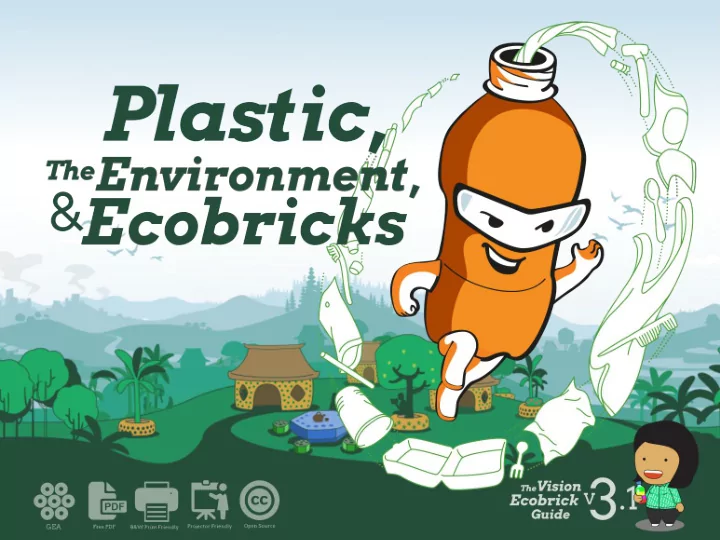

When plastics are littered, burned or dumped, they poison the Earth, Air, and Water. When we save, segregate and pack plastics into bottles, we can make building blocks that can be reused over and over again. Together we can build green spaces that enrich our community and environment.
When do you use Plastic?
Why Plastic?
What is plastic?
Where does your plastic go?
Plastic is either recycled, dumped, burned or washed away. Where does plastic go after that?
What about Recycling?
There are different grades of plastic. When recycled, plastic is down-cycled to a lower grade. The lower the grade the less the value. The less the value, the less likely it is to be recycled again. In the end a bottle is eventually recycled down into a plastic that can no longer be recycled.
Recycling just isn't a perfect circle like nature. Industrial recycling down-cycles plastic until In the natural environment the plastic can no longer be used or it everything works in circles of falls out of the system into the biosphere 100% use and re-use.
In the end, every molecule of plastic that we consume ends up in the Environment. But what is ‘the environment’? But what is ‘the environment’?
What do you see here?
These plastics don't fit into the Environment.
What do you see here?
The ‘Environment’
Plastic poisons our local ecosystems.
Remember that smell of plastic burning? Plastic + fire or sun or water creates poisonous molecules.
When burned, plastic creates poisonous dioxin molecules that then rain back down onto fields and forests.
The UV rays from the sun cause plastic to break down into smaller and smaller pieces. This process creates more poisonous molecules that enter the environment.
This process of plastic photodegredation happens on land and water. In water it releases toxic molecules.
Plastic molecules don't fit into our human systems. They emulate estrogen, which can cause birth defects, cancer and degenerative diseases. These molecules bioaccumulate in our bodies and are passed on through mothers to the young.
So what can we do?
Reduce our consumption Avoid plastic as much as possible Use biodegradeable materials Make ecobricks!
Ecobricks are one solution! Cradle to Cradle Design: Learning from nature, Ecobricks are a building block that can be used over and over again!
How to make an Ecobrick? Making an Ecobrick is simple. But, start right— this is a long-term lifestyle habit that you are beginning. Your first ecobrick is your most important-- follow the simple guidelines to make it great.
1 Segregate, collect and prepare plastics of all kinds to make your ecobricks.
2 Choose your brand of bottle carefully. What is most abundant in your community? Having identical sized ecobricks will make building smoother.
3 Use a bamboo or wood stick to pack. Avoid metal, glass which can rupture the bottle. Avoid paper and food that will biodegrade.
4 Use a colored soft plastic to give the brick bottom a color. This will make your ecobrick constructions colorful!
5 It is important to maintain high quality ecobricks. Weigh your Ecobricks to ensure quality. Refuse low quality ecobricks. 0.35g/ml is a good minimum ecobrick density
6 Use a log sheet or Be sure to label the GoBrik app to each ecobrick once log each ecobrick it has been logged as it comes in. with key info: This way you can name, date, weight, track your serial. community progress. Use the web browser on your phone or computer to vist our www.GoBrik.com webapp.
7 GoBrik is a powerful tool for logging and connecting your ecobricks. Use it to track personal and community progress.
Build! Once you have enough Ecobricks you’re ready to build. Ecobricks can build modules, gardens and structures.
Ecobrick Modules The easiest, fastest, and perhaps the funnest Ecobrick application, is to make Milstein modules for horizontal building and Dieleman modules for vertical building. With modules you can create benches, table, chairs and more.
Green Spaces Perhaps the best use for Ecobricks is building community green spaces. Using local earth and ecobricks you and your community can build beautiful spaces that enrich the local environment.
Want to know more about Ecobricks and Building? Get all the resources. Free. www. Ecobricks .org
x Lead Authors The best Ecobrick of All, is the Russell Maier, Irene Angway, Ani Himawati one that you don’t have to make. Ecobricks are a solution for Illustrations El Tiburon Grande (Philippines), Jo Stodgel today’s plastic challenge. But for (U.S.A), Russell Maier (Canada), Astrid Gruber tomorrow, let’s work together to (Germany), Elena Molchanova (Trinidad). Fabianus Bayu (Indonesia).. live in world that has a lot less plastic and a lot more organic. Bali and Indonesia development Agung Sutama, Pak Ngurah, Ibu Faiz This presentation is free to copy, share and The Vision Ecobrick Guide is licensed under a remake. Download your free copy at Creative Commons Attribution-ShareAlike 4.0 www.ecobricks.org International License.
Recommend
More recommend